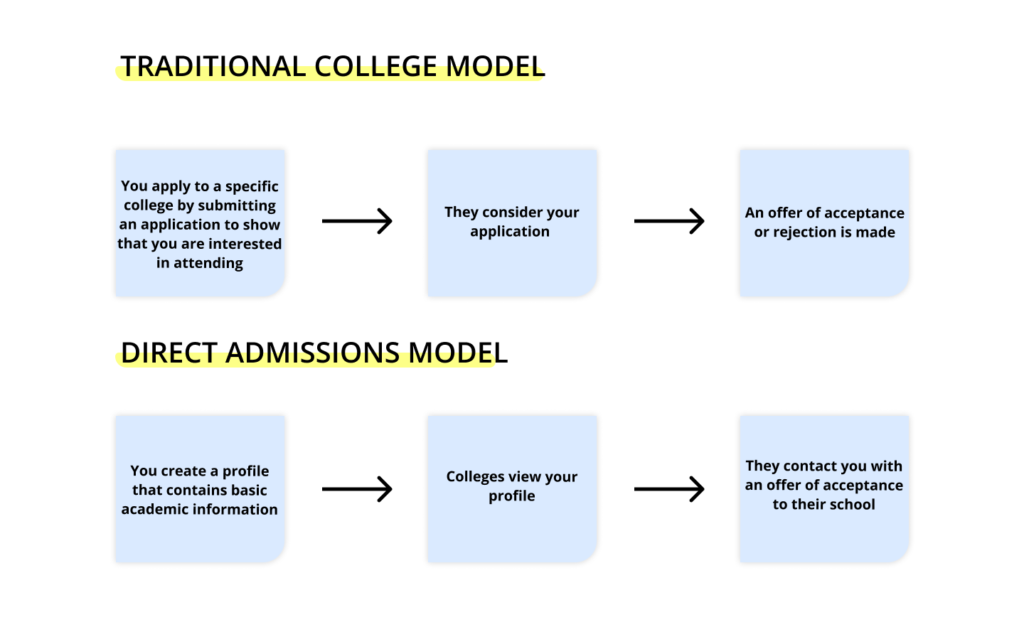Student-centric advice and objective recommendations
Higher education has never been more confusing or expensive. Our goal is to help you navigate the very big decisions related to higher ed with objective information and expert advice. Each piece of content on the site is original, based on extensive research, and reviewed by multiple editors, including a subject matter expert. This ensures that all of our content is up-to-date, useful, accurate, and thorough.
Our reviews and recommendations are based on extensive research, testing, and feedback. We may receive commission from links on our website, but that doesn’t affect our editors’ opinions. Our marketing partners don’t review, approve or endorse our editorial content. It’s accurate to the best of our knowledge when posted. You can find a complete list of our partners here.
What is Direct Admission? Everything You Need to Know
 By
Cait Williams
By
Cait Williams 
Cait Williams is a Content Writer at Scholarships360. Cait recently graduated from Ohio University with a degree in Journalism and Strategic Communications. During her time at OU, was active in the outdoor recreation community.
Full BioLearn about our editorial policies

Bill Jack has over a decade of experience in college admissions and financial aid. Since 2008, he has worked at Colby College, Wesleyan University, University of Maine at Farmington, and Bates College.
Full BioLearn about our editorial policies

Maria Geiger is Director of Content at Scholarships360. She is a former online educational technology instructor and adjunct writing instructor. In addition to education reform, Maria’s interests include viewpoint diversity, blended/flipped learning, digital communication, and integrating media/web tools into the curriculum to better facilitate student engagement. Maria earned both a B.A. and an M.A. in English Literature from Monmouth University, an M. Ed. in Education from Monmouth University, and a Virtual Online Teaching Certificate (VOLT) from the University of Pennsylvania.
Full BioLearn about our editorial policies

For a long time the college admissions process has been marked by prestige, competition, and a lot of unspoken gatekeeping. The future of college admissions may be taking a turn from all of those things through an idea called “direct admission,” which hopes to break down some of those barriers. It has risen significantly in popularity in the past several years, and is expected to grow over the next few years. So, let’s talk about it!
What is direct admission?
Let’s start with an explanation of direct admission, which is designed to offer students admission into college without making students go through the whole college admissions process. Take a look at the two models below:

Rather than entire applications, students will make a profile that includes things such as their GPA, where they attend high school, their grade level, and other general information. Colleges will then be able to view these profiles and offer admissions to the students that fit their admissions criteria.
The goals of direct admission
Changing the college admissions process is an enormous undertaking, but that’s exactly what direct admission is setting out to do. They’re targeting major hurdles that have plagued the college world both recently and for some time now: Money, diversity and declining enrollment.
Money
On average, college applications can cost between $50-$90 dollars each. It is generally recommended that students apply to between 5-8 colleges that are a mix of safety, reach and match schools. Let’s look at some numbers:
| Number of colleges | Application Cost | Total cost of applying |
| 5 | $50 – $90 | $250 – $450 |
| 6 | $50 – $90 | $300 – $540 |
| 7 | $50 – $90 | $350 – $630 |
| 8+ | $50 – $90 | $400 – $720+ |
The numbers above are no small amount of money, especially when you think about the fact that even if you are admitted to all those schools, you’ll only be able to attend one. With direct admission though, the cost of applications is almost entirely mitigated, eliminating a huge financial barrier.
Keep in mind that some sites that allow you to create a high school profile may still have a cost that comes with them. However, this cost should be relatively small compared to college application costs, and may be able to be waived for students who qualify.
Increase diversity and change demographics
Through the direct admissions process, colleges are hoping to extend their reach to students who may not have the option to apply to college in the conventional ways. Colleges and universities want to see an increase in diversity and varying student demographics. The Common App specifically wants to aid “first generation and lower-income students”.
Reverse the decline
While it may be hard to believe, college admissions have actually seen a steady decline over the past decade. Student debt has become more and more problematic and a lot of people either don’t want to take debt on, nor do they have the money to pay for school upfront. With direct admission though, some people believe the tide may turn and enrollment will begin to steadily rise. It’s true that direct admission may not directly enroll students, but an increase in admissions offers should at least open the door for more students to see college as an option.
Where it all began
The first state to implement direct enrollment was Idaho. The program began in 2015 and has only grown over the past several years. Students can count on being offered admission to at least six different state schools after graduating from high school.
But Idaho wasn’t the only one to jump on the direct admission train. In 2021, the Common App launched its first pilot program for direct admissions. In order to participate, students simply had to make a common app profile and provide some basic academic information. From there, the six participating colleges that The Common App partnered with offered admissions to students whose profiles matched their entrance criteria. Common App now partners with seventy colleges.
The Common App is not the only one beginning to offer programs like this though. Companies like Niche and Concourse are also partnering with colleges to offer students access to direct admission colleges.
Financial aid and direct admission
Some colleges may be able to offer you a financial aid offer along with your admissions offer. However, not all colleges are guaranteed to make you those offers at the same time. For most students who will use direct admission to enter into college, financial aid will be an important piece of the puzzle. Reach out to schools you’re interested in to ask about their financial aid policies.
To accept or not accept
While it may seem counterproductive to hear, the truth is that just because you received an offer from a college does not mean that you should necessarily accept their offer. Beyond an acceptance letter, you’ll need to think of the total cost of attendance, how to pay for housing, monthly expenses, if you’ll have reliable transportation to or around campus, and so on. There are a lot of moving parts in the college process. While we don’t want you to become overwhelmed, we also don’t want you to overlook anything. Take your time with these important decisions.
How do you participate in direct admission?
Direct admission is still relatively new and not something that is widely used. So, in order to take part in this process, you’ll need to identify where you can make a profile and what colleges can then view that profile.
Not all colleges will have the same requirements for direct admission. Some colleges may only require students to have graduated from high school, while others may require a certain GPA or SAT / ACT score. Speak to your guidance counselor, as they should be able to provide you more specific information that is relevant to where you live and what your options are.
What it all means…
The future of direct admissions isn’t certain. As we said above, changing the college admissions process is no small task and it’s not certain that it will actually cause enrollment and therefore graduation rates to rise. It’s unclear how direct admission and financial aid will come together. For now, it’s a starting point from which specific barriers can begin to be broken down. It’s unclear how direct admissions may look at colleges like Harvard or Stanford, which are known for their rigorous application requirements. Again, it’s an issue that only time will tell.
Frequently asked questions about direct admission
What is reverse admission?
What are the benefits of direct admission?
What is a direct admission major?




 SAT" printed on his pencil">
SAT" printed on his pencil">
